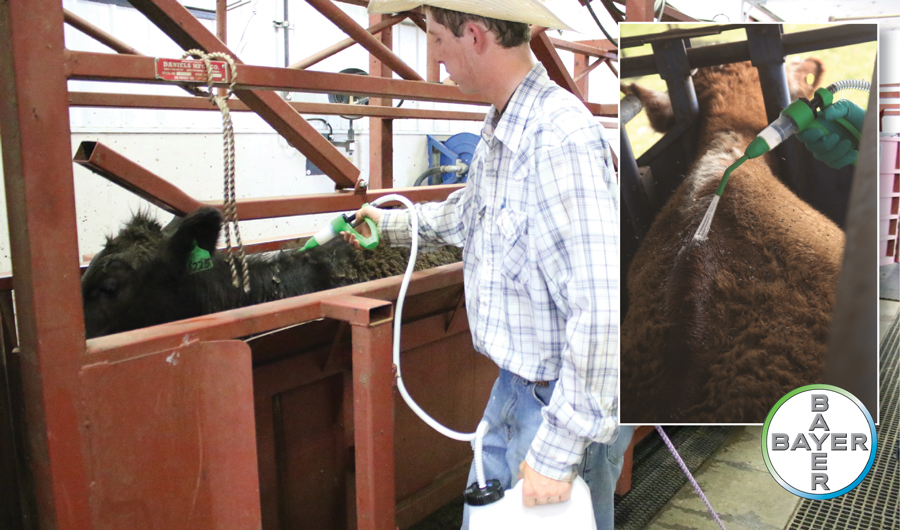Getting Insecticide Applications Right

By Caitlin Richards
When it comes to insecticide application there’s a sweet spot. Sometimes producers have their own idea of what that “sweet spot” dose is, and it may differ from the insecticide’s label. The actual sweet spot for an insecticide, though, is the application rate or dose listed on the label.
“The companies sponsoring insecticides go to great lengths to establish dose,” says Larry Hawkins, senior technical service veterinarian with Bayer Animal Health. “Research-based data determines what dose to use.”
The scientific study, Hawkins explains, is set up by applying different dosage amounts to livestock and then tracking the efficacy of each dosage amount.
For example, doses of 10, 20, 30 and 40 units will be applied to the livestock. Researchers will determine the effect of each dosing amount. If they find a dose of 30 units works as well as a dose of 40 units, then the dose set on the label would be 30 units.
Hawkins says, “We want to use insecticides to get the best performance possible and use the least amount of product. When we don’t use the correct dose, we are compromising our effect.”
Right dose protects the cattle and the cash
Producers are faced with a long list of tasks when caring for their cattle. Being in a hurry to cross off all those tasks can sometimes lead to error when it comes to insecticide application. Most likely, a producer is under- or over-applying their insecticide of choice with their own idea of a sweet-spot dose.
While there is no toxic or life-threatening concern of over- or under-applying an insecticide, except in extreme cases, the biggest threat is to a producer’s bottom line. By not using an insecticide’s issued dose, a producer could be pouring on extra dollars by over application or spending double the dollars by under applying.
“If it is an expensive product, then applying more is cutting into your pocketbook,” Hawkins says. “We have already done the studies to determine the maximum level for the product to work, and applying more does not improve it any.”
The science behind the label’s dose should tell producers that more isn’t necessarily better. The thought of applying more now to prevent another application later is incorrect. Hawkins explains that the cost of applying more does not add enough to the efficacy to be beneficial.
Producers should pay special attention to the label dose to ensure a toxic amount is not given to their cattle. An overdose of 5 to 10 units isn’t where the concern lies. It is in the excessive over-application.
“The insecticides we have today are safe if used according to label directions,” Hawkins says. “I am not aware of any product that even if it were accidentally applied at 2 times the dose the livestock would be adversely affected. However, there would be concerns with meat and milk withdrawal [times].”
The same threat to a producer’s pocketbook is present with under-application. If a producer fails to apply the correct dose, the efficacy of the product is greatly reduced. Re-application may be needed, causing yet another expense for the producer. Again, the science behind the label’s dose tells the producer this.
“If you under-dose then, of course, you reduce your efficacy as well,” Hawkins says. “So, your performance has the potential to suffer.”
An unexpected effect of under-dosing
While some levels of under-dosing may still kill off some of the parasites or bugs, there may be parasites or bugs that survive an under-dose.
Hawkins explains that this is, in part, because certain species of parasites or bugs require more insecticide to have the desired effect. Therefore, a given parasite or bug may have the ability to resist the applied insecticide.
“If we kill off the ones that are susceptible, then the only population that is left are the ones that are resistant to that particular insecticide,” Hawkins says. “So, by under-dosing, the population that is resistant to the insecticide survives and soon the entire population is resistant.”
As an example, say that a producer under-doses by 25 percent. While their cost would be cut by 25 percent, they could be missing the parasite population that requires the 25 percent more product.
There is no way of knowing what percentage of the parasite or bug population that may be, which Hawkins explains may be even more significant.
“Unfortunately, some of the most pathogenic parasites are the ones that are most likely to develop resistance to a product,” Hawkins says. “So, they would be the ones most likely to cause a problem. When we under-dose, 2 things have occurred — we have exposed a pathogenic parasite to a low dose and we haven’t killed them all. And because it is the most pathogenic parasite, it probably has the most detrimental effects on the animal; therefore, it causes the most economic loss.”
Apply the right dose the right way
Under-application can occur through misapplication of a product as well. While a producer may be applying the correct dose, they may not be applying it to the correct areas on the livestock.
Hawkins gives the example of a product used to treat lice in cattle. Labels specifically state a dose and where the product should be applied. For this specific product, the label states that a small application should be made to the head and then the remainder of the application should be made from the withers to the tail head.
There is a species of lice, Hawkins says, that is found primarily on the head of cattle. Therefore, if a producer applies the dose only from the withers to the tail head and misses the head application, they would be in an under-dose situation.
“So even though we might put the right amount on the animal,” Hawkins says, “if we didn’t follow the label directions, the product could be ineffective because it could only kill the lice it came in contact with from the withers to the tail head.”
Apply the right dose for the right weight
Another common application error that results in both under- and over-application, Hawkins warns, is guessing the weight of the cattle. Most of the doses on an insecticide are set for the weight of the livestock.
If a producer uses a set amount across the whole herd, they could be wasting money on smaller animals because of over-application and not applying enough to heavier or larger animals. A set of scales will help a herd owner determine the right dose for the livestock.
Coming up with their own idea of a sweet spot may not be totally worth it for producers. After purchasing the product, the science-backed sweet spot is instantly in their hands — right on the label. By using the label’s sweet spot, producers can eliminate over- and under-application problems and ultimately protect their pocketbooks.
“Getting Application Right” is excerpted from the January 2018 issue of The Cattleman magazine.
